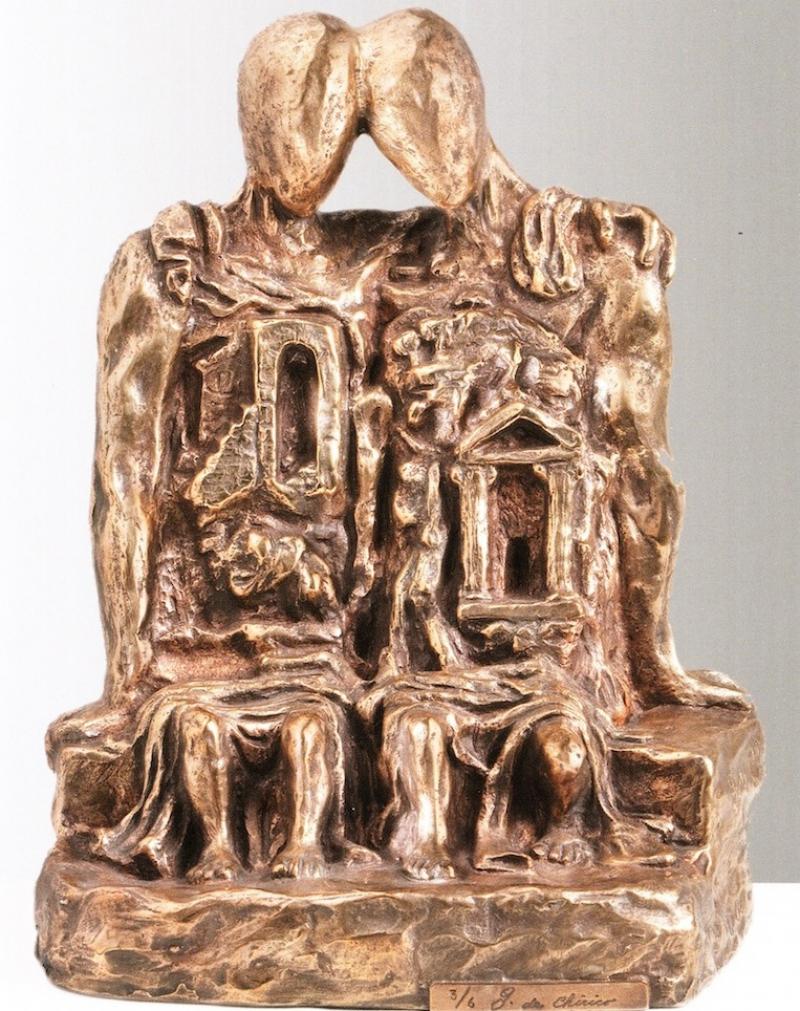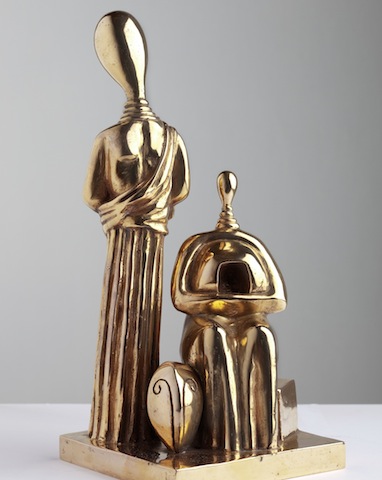Giorgio de Chirico: Myth and Mystery, Estorick Collection | reviews, news & interviews
Giorgio de Chirico: Myth and Mystery, Estorick Collection
Giorgio de Chirico: Myth and Mystery, Estorick Collection
The artist's late work was once dismissed, but is it time for a reassessment?

An exhibition of work by a giant of 20th-century painting cannot reasonably be expected to turn up too many surprises; the most we can usually hope for is a good proportion of lesser-known works to temper the “masterpieces”. To reveal a whole body of work hitherto ignored by art historians is something of a coup, but the Estorick Collection’s new show does just this, introducing over 20 sculptures that will be unknown to all but the most committed fans of Giorgio de Chirico.
Known almost exclusively as a painter, de Chirico (1888-1978) is famous for his series of bizarre but seminal paintings that set out the iconography of Pittura metafisica, using strange juxtapositions, faceless figures and distorted perspectives to fuel a sense of anxiety and estrangement. Metaphysical painting, in particular works like de Chirico’s The Song of Love, 1914, was hugely admired by the Surrealists, and for a time, de Chirico was the toast of the avant-garde.
The iconography of mannequins, automatons and tailors’ dummies is instantly recognisable
Perhaps due to his early years in Greece and his Italian parentage, the classical tradition was never entirely absent from his practice and in 1919, de Chirico appalled the Surrealists by making a series of copies of Old Master paintings. De Chirico appeared to have retreated under the comfort blanket of tradition, and he was ostracised as a reactionary by the avant-garde for whom he had once been a hero. This narrative of de Chirico’s decline has held fast, and his later career, characterised by obsessive reworkings of paintings by Renaissance masters as well as from his own Metaphysical period, has until recently been largely dismissed.
It was during his “decline” that de Chirico began experimenting with sculpture, and the iconography of mannequins, automatons and tailors’ dummies, so familiar from the Metaphysical paintings, is instantly recognisable. Although de Chirico did not begin producing sculpture until the 1930s, the nature of the medium was a longstanding preoccupation; in Horses of the Seashore, 1962-1963, the horses appear too animated to be statues, but too lifeless to be living creatures, the rubble of ancient ruins giving the impression that they have somehow broken free of their sculpted form.

At the root of de Chirico’s eventual abandonment by the avant-garde was the belief that he had dropped modernism in order to embrace classicism. It is perhaps surprising then to find that the overtly classicising sculpture Ippolito (Greek Ephebe in Horseback), 1969, was made in the same year as The Colonials, a silvered bronze that deploys the faceless mannequin heads, distorted limbs and torsos filled with strange objects, so central to Metaphysical iconography. Not only does this exhibition refute the idea that an artist’s career develops chronologically, it also gives some insight into de Chirico’s single-minded, perhaps even pathological, determination to perfect the themes and motifs of his work.
Explore topics
Share this article
The future of Arts Journalism
You can stop theartsdesk.com closing!
We urgently need financing to survive. Our fundraising drive has thus far raised £49,000 but we need to reach £100,000 or we will be forced to close. Please contribute here: https://gofund.me/c3f6033d
And if you can forward this information to anyone who might assist, we’d be grateful.

Subscribe to theartsdesk.com
Thank you for continuing to read our work on theartsdesk.com. For unlimited access to every article in its entirety, including our archive of more than 15,000 pieces, we're asking for £5 per month or £40 per year. We feel it's a very good deal, and hope you do too.
To take a subscription now simply click here.
And if you're looking for that extra gift for a friend or family member, why not treat them to a theartsdesk.com gift subscription?
more Visual arts
 'We are bowled over!' Thank you for your messages of love and support
Much-appreciated words of commendation from readers and the cultural community
'We are bowled over!' Thank you for your messages of love and support
Much-appreciated words of commendation from readers and the cultural community
 Folkestone Triennial 2025 - landscape, seascape, art lovers' escape
Locally rooted festival brings home many but not all global concerns
Folkestone Triennial 2025 - landscape, seascape, art lovers' escape
Locally rooted festival brings home many but not all global concerns
 Sir Brian Clarke (1953-2025) - a personal tribute
Remembering an artist with a gift for the transcendent
Sir Brian Clarke (1953-2025) - a personal tribute
Remembering an artist with a gift for the transcendent
 Emily Kam Kngwarray, Tate Modern review - glimpses of another world
Pictures that are an affirmation of belonging
Emily Kam Kngwarray, Tate Modern review - glimpses of another world
Pictures that are an affirmation of belonging
 Kiefer / Van Gogh, Royal Academy review - a pairing of opposites
Small scale intensity meets large scale melodrama
Kiefer / Van Gogh, Royal Academy review - a pairing of opposites
Small scale intensity meets large scale melodrama
 Jenny Saville: The Anatomy of Painting, National Portrait Gallery review - a protégé losing her way
A brilliant painter in search of a worthwhile subject
Jenny Saville: The Anatomy of Painting, National Portrait Gallery review - a protégé losing her way
A brilliant painter in search of a worthwhile subject
 Abstract Erotic, Courtauld Gallery review - sculpture that is sensuous, funny and subversive
Testing the boundaries of good taste, and winning
Abstract Erotic, Courtauld Gallery review - sculpture that is sensuous, funny and subversive
Testing the boundaries of good taste, and winning
 Edward Burra, Tate Britain review - watercolour made mainstream
Social satire with a nasty bite
Edward Burra, Tate Britain review - watercolour made mainstream
Social satire with a nasty bite
 Ithell Colquhoun, Tate Britain review - revelations of a weird and wonderful world
Emanations from the unconscious
Ithell Colquhoun, Tate Britain review - revelations of a weird and wonderful world
Emanations from the unconscious
 Rachel Jones: Gated Canyons, Dulwich Picture Gallery review - teeth with a real bite
Mouths have never looked so good
Rachel Jones: Gated Canyons, Dulwich Picture Gallery review - teeth with a real bite
Mouths have never looked so good
 Yoshitomo Nara, Hayward Gallery review - sickeningly cute kids
How to make millions out of kitsch
Yoshitomo Nara, Hayward Gallery review - sickeningly cute kids
How to make millions out of kitsch
 Hamad Butt: Apprehensions, Whitechapel Gallery review - cool, calm and potentially lethal
The YBA who didn’t have time to become a household name
Hamad Butt: Apprehensions, Whitechapel Gallery review - cool, calm and potentially lethal
The YBA who didn’t have time to become a household name

Add comment